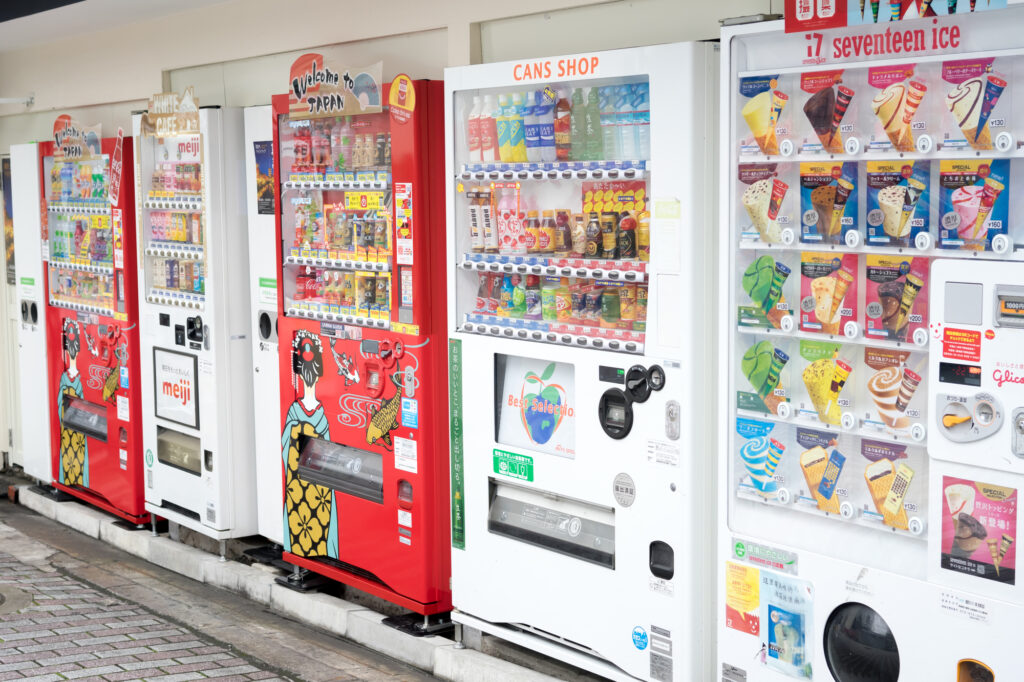Japan is famous for many things, and to anyone familiar with the nation’s unique culture, it won’t come as a surprise that vending machines have attained legend-like status abroad. There’s a vending machine for everything—from soda to toys, t-shirts to pizza, you can buy just about anything in a matter of seconds from a nearby vending machine.

Why are vending machines so popular in Japan?
Vending machines have become synonymous with Japan, and it’s easy to see why. It’s mainly due to the fast-paced lifestyle of the Japanese people, as well as their mostly-urban population.
Most Japanese adults keep tight schedules, reflected by the country’s efficient train system and multitude of quick shopping options like convenience stores and vending machines. Japan has worked hard over the years to integrate technology into everyday life in a seamless way, so it’s no wonder the country’s vending machines have become so advance.
Trivia and facts about Japanese vending culture
By most estimates, Japan has more than 5 million vending machines across the country—that’s a huge number. There’s a vending machine on almost every street corner in big cities like Tokyo, Osaka, Sendai, Sapporo or Kyoto, and some are even lined up in a row, so you don’t have to walk far for an impressive selection of snacks, drinks and other consumables.
Here are a few astounding facts and cultural anomalies about Japanese vending machines to consider the next time you’re faced with one:
- Most vending machines are cashless. Japan is known for its high-speed culture. After all, the country’s well-known for its technology, robots and push toward automation. Japanese society values convenience, and you can see this concept even in the country’s ubiquitous vending machines. Most Japanese people pay for vending machine items with a convenient commuter pass, but some take coins, too. Contactless purchases are popular in Japan, so all it takes is a swipe of your card and your beverage, snack or even a brand-new t-shirt is ready for you in seconds below.
- Variety is common in vending machines. It’s surprising how much stuff can fit into a small vending machine. Whether you’re standing in front of a machine that specializes in drinks, one that serves ready-to-eat meals or one that offers collectable toys, you’ll find tons of variety at your fingertips.
- Touch screens are changing the game. While you’ll find traditional vending machines in nearly every city in Japan, touch screens are truly taking over. Japanese vending machines of today are touch screen operated, and you can even get recommendations if you stand in the right spot. Some machines are even programmed to send messages that brighten your day.
- The machines are aesthetically designed. Japan takes aesthetics seriously—you can see it in almost every aspect of daily life, from architecture to fashion, illustration and more. Even simple vending machines are designed with looks in mind. Machines can be covered in brand logos, anime characters, adorable illustrations and so much more.
- There’s a vending machine for everything. No matter what you’re looking for, from snacks to clothing, there’s a vending machine in Japan that has a variety of great options to choose from. There are vending machines serving both hot and cold drinks, full meals like pizza or soup, ramen-making kits and so much more. You’ll also find machines offering personal care items, t-shirts and other everyday goods. It’s all about convenience, and you’re never far from the items you need.
- They’re everywhere! There’s approximately one vending machine in Japan for every 23 people, and combined sales from all of the country’s machines totaled more than $60 million USD in recent years. In fact, there are so many vending machines in Japan that if you placed them side-by-side, the line would stretch all the way from Tokyo to Hawaii. It’s safe to say that nearly everywhere your travels take you during your stay in Japan, there’s a vending machine to satisfy almost any need just footsteps away.
- Vending has been popular for decades. Vending machines are practically ingrained in Japanese culture and everyday life. The first vending machines trace their roots back to the 1920s, when candy machines brought flavor and color to the sidewalks of Japanese cities. By the 1950s, vending machines were serving up fresh, cold fruit juices. Nearly half-a-century after their introduction, vending machine makers truly stepped up their game in the 1970s, as machines were now capable of dispensing both hot and cold items.
- Hot and cold vending machines exist. While hot and cold vending machines exist around the world, you won’t find the variety of items like the ones at your fingertips in Japan. If you’re in cities like Osaka, Tokyo, Kyoto and more, you’re never far away from a piping hot beverage, like fresh coffee or tea, dispensed from your nearest vending machine. You can even find vending machines serving warm soup or baked pizza. No matter your cravings, there’s likely a vending machine out there on the Japanese streets waiting for you to make your selection.
- Vending machines are programmed to help customers. Vending machines feature intuitive technology that allows them to assist their customers in more ways than simply dispensing items. Many machines can even sense when a natural disaster occurs, giving the machine the green light to dispense food and drinks for free to those in need. They’re even equipped with backup batteries or generators, so they’ll keep dispensing even if the power’s out. Since gyms and schools are the primary evacuation centers during emergencies, you’ll find them packed with all types of vending machines to meet nearly any need.
- You can buy alcohol on the go. This one’s a real shocker to first-time visitors to Japan—you can even buy alcoholic beverages from vending machines! There are machines that offer beer, pre-made cocktails and even sake in bigger cities and rural regions alike. The legal drinking age in Japan is 20, and you’ll need an identification card to make your purchase. The machine scans your card, delivering your beverage if you’re of age. You can even grab your favorite pack of cigarettes from nearby vending machines if you want to satisfy all your vices at once.
- You can also find quick hangover cures. After a night of drinking, come back to a nearby vending machine for a “hangover cure.” Clam and miso soup—claimed by the Japanese to be the premier hangover cure—can be found in vending machines close to bar districts and busy train stations. Look out for the cartoon logo of a smiling man holding a frothy beer mug, and you know you’re just seconds away from relief.
- Try the Lucky Dip vending machine. If you’re visiting Japan and you spot a Lucky Dip vending machine, give it a try. Just insert a 1,000 yen note (worth roughly $10 USD), and the machine dispenses a mystery item. The machine displays the potential items you could get, including some high-priced items like sunglasses or cameras. You could get lucky and end up with a new phone!
- They always work. Japan is known for consistency and reliability, and vending machines are no different. Vending machines are well-maintained, and they’re always working. No matter where you are, no matter what you need, there’s likely a vending machine nearby waiting for you to make your purchase.
- Celebrity endorsements are common. Japan loves Hollywood, and you can even see it in the country’s vending machine culture. So many of Hollywood’s leading men have graced Japanese vending machines, from Arnold Schwarzenegger to Bruce Willis. They’ve endorsed products as varied as coffee, shampoo and even cup noodles. Today, Tommy Lee Jones is, surprisingly, one of the most famous faces on Japanese vending machines—when you spot his distinctive face, you know you’re close to a great cup of piping-hot coffee, made fresh and dispensed in a matter of seconds.
- Vending machines are even found at temples. While it might come as a surprise that ancient temples in Japan have vending machines, it’s for a very practical reason. Many people who visit Japanese temples leave paper fortunes, called omikuji. Traditionally, visitors make a donation then select a paper fortune from a wooden box. Now, there are vending machines that dole out omikuji in exchange for a few coins—it couldn’t be easier!
- There’s no room for new vending machines! While the Japanese love their vending machines, they understand that too much of a good thing can become problematic. That’s why they’ve reached their limit for new vending machines. In 2017, the country decided there are no more available spots for vending machines to be installed.
Experience the impressive variety of vending machines for yourself!
If you’re planning a visit to Japan, prepare to have your mind blown nearly every time you turn your head. From ancient temples to eye-catching neon signs, the country is full of unique history complemented by the modern technological marvels of today. As you’re exploring the country, be sure to check out the wide variety of vending machines—it’ll be hard not to, as they’re practically on every corner. Visit Japan and enjoy convenience at its very best!
- How Much Money Can You Make Teaching English in Japan? - December 12, 2022
- The Best Places to Teach English in Japan - December 9, 2022
- The Best Credentials for Teaching English in Japan - December 8, 2022








